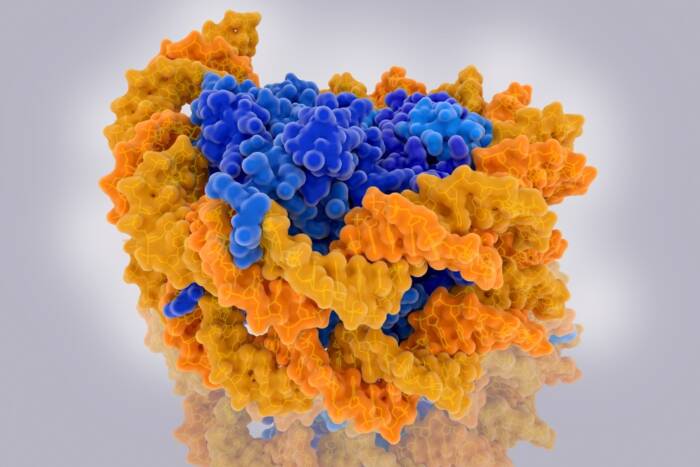|
GARBAGE

The ongoing campaign to reduce, reuse and recycle at Rockefeller got a substantial boost this year with an increase in the number of recycling bins in offices, hallways and laboratory and building common areas. The increased use of green bins (for mixed paper and cardboard) and blue (for cardboard, certain plastics, glass and metal) have resulted in a 100 percent increase in the amount of recyclable materials collected on campus, to two tons a month.
Plant Operations and Custodial Services are working together to spread the word on the new policy to ensure that garbage and recyclables are no longer mixed. “The city sanitation department has strict rules about what recyclables they’ll take, so even a cup of coffee accidentally thrown into a recycling bin means everything in that bin becomes garbage,” says Roland Volcy, assistant manager of custodial services. “If everyone does their part, we can reduce our waste even further.”
Efforts by Restaurant Associates to promote use of reusables in Weiss Café has led to an additional decrease in garbage — more than 28 percent between 2006 and 2007 and another 14 percent last year.
In December, Communications and Public Affairs announced an opt-out system for printed materials that are also available online, and over 10 percent of the campus has elected to stop receiving hard copies of BenchMarks, the Peggy Rockefeller Concerts brochure, the university phone directory and/or the Zagat Neighborhood Guide.
CLIMATE CONTROL

Because there’s no need for air conditioning when there’s nobody around to enjoy it, automatic holiday and nighttime setbacks have been instituted for lighting and temperature control systems in common areas of buildings. Old air conditioners in Faculty House are being replaced with new, Energy Star compliant models as the apartments turn over, and 150 of the units have so far been replaced. (In addition, the university receives a $100 rebate for each new unit from the New York State Energy Research and Development Authority.) A policy instituted this month goes even further, lowering demand on central air conditioning in common areas by raising the temperature three to five degrees Fahrenheit. This by itself will save as much as $250,000 a year. “These and other energy and climate measures have enabled the university to stabilize its energy expenditure while continuing to expand its operations,” says Mr. Kogan. Plans currently under consideration include mandating that the doors of main entrances remain closed when not in use.
ENERGY

Rockefeller is enrolled in the Renewable Energy Credits program of Hess Corporation, the university’s energy supplier, guaranteeing that the university gets 20 percent of its energy from solar, wind and hydroelectric sources.
An emphasis on efficiency, meanwhile, has led to the installation of new compact fluorescent T5 lights — far more efficient than traditional incandescent bulbs — in Rockefeller Research Building and Weiss Research Building, saving 768,000 kWh per year. Next to be retrofitted is Detlev Bronk Laboratory, as it undergoes renovations. Light-emitting diode (LED) lights installed in elevators have reduced the amount of energy for lighting by 75 percent in elevator cabs. Altogether these upgrades have reduced Rockefeller’s lighting electrical loads by nearly 50 percent in RRB and Weiss. Not only does that save the university an annual $130,000, it also saves the environment from an estimated 769.3 tons of greenhouse gases, 56.9 pounds of volatile organic compounds, 2,386 pounds of nitrogen oxides, 370 pounds of carbon monoxide, 6,720 pounds of sulfur dioxide, 60 pounds of particulates and 5,772 milligrams of mercury each year. According to calculations from Performance Efficiency Solutions Group, the university has effected the equivalent of removing 318 cars from the road and planting 1,786 CO2-absorbing trees.
Fume hoods, an essential environmental safety component in most labs, are large energy consumers. The university has enacted an awareness campaign asking lab workers to close fume hood sashes when hoods are not in use. Doing so may save up to $1,800 per hood per year in energy costs.
Plans currently under consideration include: programming residential elevators for skip-stop service; switching the fuel used in the university’s duel-fuel burners from oil to gas whenever feasible; installing additional LED fixtures in areas that require 24/7 lighting; taking measurements of lab and residential refrigerators to develop temperature guidelines and set efficiency standards for purchasing new units; and installing more waterless urinals to reduce water usage.
HAZARDOUS WASTE

According to analyses made over the last several months, the university collects approximately 60 pounds of alkaline batteries, 550 fluorescent light bulbs and dozens of printer cartridges every month from both work and home use, preventing the toxic heavy metals, mercury and petroleum composites in these products from reaching landfills where they can seep into soil, groundwater and air.
|






